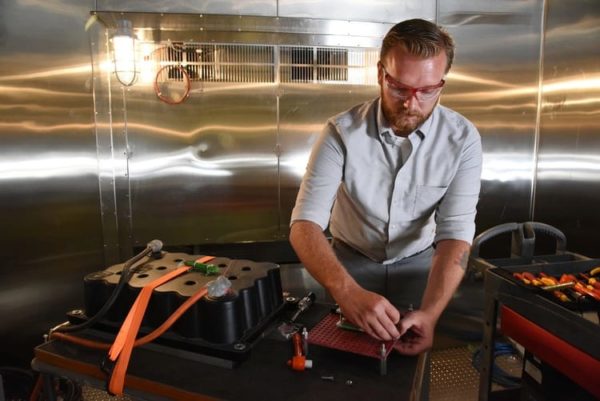The rectifier is a critical motorbike part that you can’t afford to ignore. Some riders find their rectifier getting hot after riding. And this raises the question, do motorcycle rectifiers get hot?
The rectifier converts AC current to DC current so that your motorbike battery gets charged. It’s pretty standard when your motorbike rectifier gets hot; even sometimes, the rectifier’s heating temperature can hit 100F or 37.7 C. After 110F, the standard rectifier heating is considered overheating.
Let’s look at what it means for you and what you can do about it. While writing this post, I leave no stone unturned so that you can get reliable knowledge quickly.
Rev Up Your Ride: Discover the Best Motorcycle Rectifier Exhaust and Insurance Combo in the US! 🏍️💨
Calling all motorcycle enthusiasts! 🌟 Want to enhance your bike’s performance with a top-notch rectifier exhaust and protect your investment with the right insurance coverage? Look no further! Our website offers customized rectifier exhausts that will elevate your ride to new heights, delivering optimal power and efficiency. Plus, get the peace of mind you deserve with comprehensive motorcycle insurance tailored specifically for you. Don’t miss out on this exciting opportunity to Ignite Your Ride with the perfect combination of top-notch rectifier exhausts and insurance coverage. Get your free quote now and hit the road with confidence! 🔥🛡️🎯
Table of Contents
Do Motorcycle Rectifiers Get Hot?
Heating motorbike rectifiers is pretty standard since your motorbike rectifier converts AC to DC current, which might cause heating.
But heating beyond a specific limit can be harmful to your motorbike’s electrical system. You’ve to figure out the difference between overheating and regular heating.
Motorbike rectifiers might overheat because of additional electrical devices you’ve installed on your motorbike. Experts never recommend installing additional electrical appliances to your motorbike beyond your battery capacity.
It’s because when you ride your motorbike, the battery drains quickly because of additional electrical devices. And there are some pre-set limits beyond which your battery can’t get a charge from the rectifier.
Think in this way, your battery can’t occupy over 70% DC charge coming from the rectifier. But because of additional electrical devices, your motorbike battery starts to demand over 70% charge.
And this miscalculation is one of the reasons why electrical devices fry. You can avoid this situation by not fitting too many electrical devices into your motorbike.
You can also refer to your motorbike manual to see the motorbike battery output capacity.
Why Do Motorcycle Rectifiers Get Hot?
Before understanding the actual reason your motorbike rectifier gets hot, you need to understand the rectifier’s role.
The motorcycle rectifier or regulator is the most crucial part which is needed to charge the battery.
The stator produces AC electrical current, but now the battery can only store DC electrical current. So to convert the AC electrical current to DC electrical energy, we need a rectifier device.
The manufacturer usually sets the rectifier as a standalone part (separate from the stator). But now, to save space and provide as much cooling, the manufacturers fit rectifiers near the alternator.
And here’s where the problem may originate from.
While riding, many charges originate from the stator passed through the rectifier, and this flow causes resistance which causes heating. Another reason why rectifiers get hot is that you’ve installed additional electrical devices beyond the battery capacity.
So it’s always better to avoid installing additional electrical devices on your motorbike.
Because additional devices demand more charge than your motorbike rectifier could allow passing through.
How Hot Do Motorcycle Rectifiers Get?
Motorbike rectifier heating is standard, and you can avoid overheating by not installing additional electrical devices on your motorbike. But have to wonder, how hot do motorcycle rectifiers get?
Generally, motorbike rectifiers get hot at temperatures of around 100F or 37.7 C. But in some cases, it can cross 110F, which is considered overheating. Manufacturers also install aluminum fins that absorb most of the heat and cool down the rectifier.
In some motorbikes like Triumph, the manufacturers installed a rectifier away from the stator, preventing overheating.
While in some motorbikes, the manufacturers are still installing rectifiers not away from the stator, which might cause more heating.
Nowadays, manufacturers are installing aluminum-made fins around the rectifier, which absorbs most of the heat. To promote more cooling, the manufacturers are also installing rectifiers where there’s enough airflow.
Also, read how motorbike alternators work. Read here.
Is the Heating of Motorcycle Rectifiers Bad?
Rectifiers sometimes act as resistance which heated the rectifiers. Now a question arises, whether the heating is terrible or good.
Heating the rectifiers is normal and can be a sign of working rectifiers. But overheating can be the sign of a faulty rectifier or faulty cooling medium around the rectifier. Pay attention to the symptoms of faulty rectifiers to know the exact reasons.
In the later section, I’ve mentioned some symptoms of faulty rectifiers.
Signs of Faulty Motorcycle Rectifiers:
Here’re some signs of faulty motorbike rectifiers to which you need to pay attention.
| Signs of a Malfunctioning Rectifier: |
| Battery discharged. |
| High RPM problems. |
| Sluggish light. |
Battery Discharged:
Rectifiers convert AC to DC, which your battery needs to charge completely. Your battery won’t charge without a suitable rectifier, and your motorbike will start using limited power.
Sluggish Light:
Sluggish light is one of the most prominent signs that can be caused when your stator or rectifier malfunctions.
Your motorbike battery starts draining if you ride your motorcycle regularly; even sometimes, you’re going to find difficulty in igniting the motorbike.
You can’t rely only on this sign as it is also caused when your battery malfunctions. It would be best to take your motorbike to a technician if you find this sign.
A faulty rectifier not only causes your battery to discharge but also interfaces with the common working mechanism of your motorbike.
High RPM Problem:
There’s a need for more energy at high RPM, which a malfunctioned rectifier can’t produce, so you’re likely to face some challenges when taking your motorbike at high RPM.
Will a Motorbike Start with Faulty Rectifiers:
Faulty motorbike rectifiers will show some signs, including sluggish light, battery discharge, and high RPM problems. Now the question arises, will a motorbike start with a faulty rectifier?
Rectifiers convert AC to DC, which your battery stores. And for starting your motorbike, you need some power storage in the battery. In the absence of a good rectifier, your motorbike battery will stop storing charge further. Eventually, in the long run, your battery will start to discharge.
And the battery discharge will cause your motorbike to not start again ever.
In simpler words, you need reliable and suitable rectifiers to ride your motorbike.
What’s the Role of Battery?
When the stator and rectifier are the main components generating charges, you must wonder what the battery’s role is. Then why do you need a battery for your motorcycle?
Try to understand one thing: your motorcycle stator only works when your motorcycle is in motion. But to bring the motorbike in motion, you need a battery.
Battery stores charge, which you need to ignite the motorcycle. Without a battery, your motorbike wouldn’t generate enough power to ignite the engine.
So to run your motorcycle effectively, you need a good battery as well as a good stator and rectifier.
How to Maintain a Motorcycle Rectifier?
Undoubtedly a rectifier is the heart of your vehicle, so it’s better to maintain your motorcycle rectifier regularly.
Here’re some tips through which you can maintain a motorcycle rectifier.
| How to Maintain a Motorcycle Alternator: |
| Wiring: Swap old copper wires (if they’re burned)with good quality, minty fresh copper wires. |
| Temperature: It would be best if you check your engine regularly and wipe any dust and debris stuck in the alternator. |
| Test problem: If you find your motorcycle light starts dimming slowly, it would be best to give at least a check to your motorcycle alternator. |
| Shift to new alternator: Swapping old alternator with new; otherwise, your motorbike will start using battery power. |
| Don’t install unnecessary devices: Installing additional devices more than your motorbike potential may harm your motorbike electrical system in the long run. |
Wiring:
The motorcycle alternator has copper wiring in it, and it might burn because of heat.
It would be best if you swap old copper wires with good quality, minty fresh copper wires. Doing this will surely add some life to your alternator and rectifier.
However, if alternator copper wires are totally burned off, please ask your technician for a better solution.
Temperature:
Any engine can only work best if it doesn’t overheat, and it’s true for your rectifier too.
It would be best to check your engine regularly and wipe any dust and debris stuck in the alternator. Avoid using any gasoline-based product for cleaning the alternator.
Test Problems:
If you find your motorcycle light starts dimming slowly, it would be best to give at least a check to your motorcycle alternator and rectifier.
It’s not always necessary that there’s a problem with your rectifier. There could be a problem with your battery or wiring, and checking the rectifier, in this case, may avoid a big problem.
Change Old Rectifier:
If there’s any problem with your rectifier, it would be best to shift to a new rectifier. Otherwise, your motorbike will start using battery power. And this might cause your motorbike battery to die.
Avoid Installing Unnecessary Devices:
Our motorbikes are starting to get more intelligent day by day, thanks to smart devices. But are installing additional devices good for your motorbike?
No, installing additional devices more than your motorbike potential may harm your motorbike electrical system in the long run.
And that’s why it would be best to check the power guide of your motorcycle and see how much output your motorcycle battery supports.
Frequently Asked Questions:
What is a motorbike rectifier?
A motorbike rectifier is a device that converts alternating current (AC) to direct current (DC) in order to charge your motorbike battery.
Why rectifier gets hots?
While riding, many charges originate from the stator passed through the rectifier, and this flow causes resistance which causes heating.
What is the maximum temperature that the rectifier can reach?
Generally, the temperature can reach a maximum of up to 110 F, but in some cases, it can cross 110F, which is considered overheating.
Is heating is the sign of a faulty rectifier?
Although rectifier heating is pretty normal, if your rectifier gets overheat frequently then you must check your motorbike rectifier.
What is the most common sign of fault alternator?
Sluggish light and battery discharged are the most common signs of a faulty alternator.
Final Verdict:
Do motorcycle rectifiers get hot? The rectifier converts AC current to DC current so that your motorbike battery gets charged.
It’s pretty standard when your motorbike rectifier gets hot; even sometimes, the rectifier’s heating temperature can hit 100F or 37.7 C. After 110F, the standard rectifier heating is considered overheating.
And don’t forget to check your rectifiers if you sense any signs of faultiness.
John, this side! My passion for motorbikes started when I was 12. I experienced many accidents and even lost some friends too. And it inspired me to create this website so that no parents in this world would lose their child while enjoying riding.


